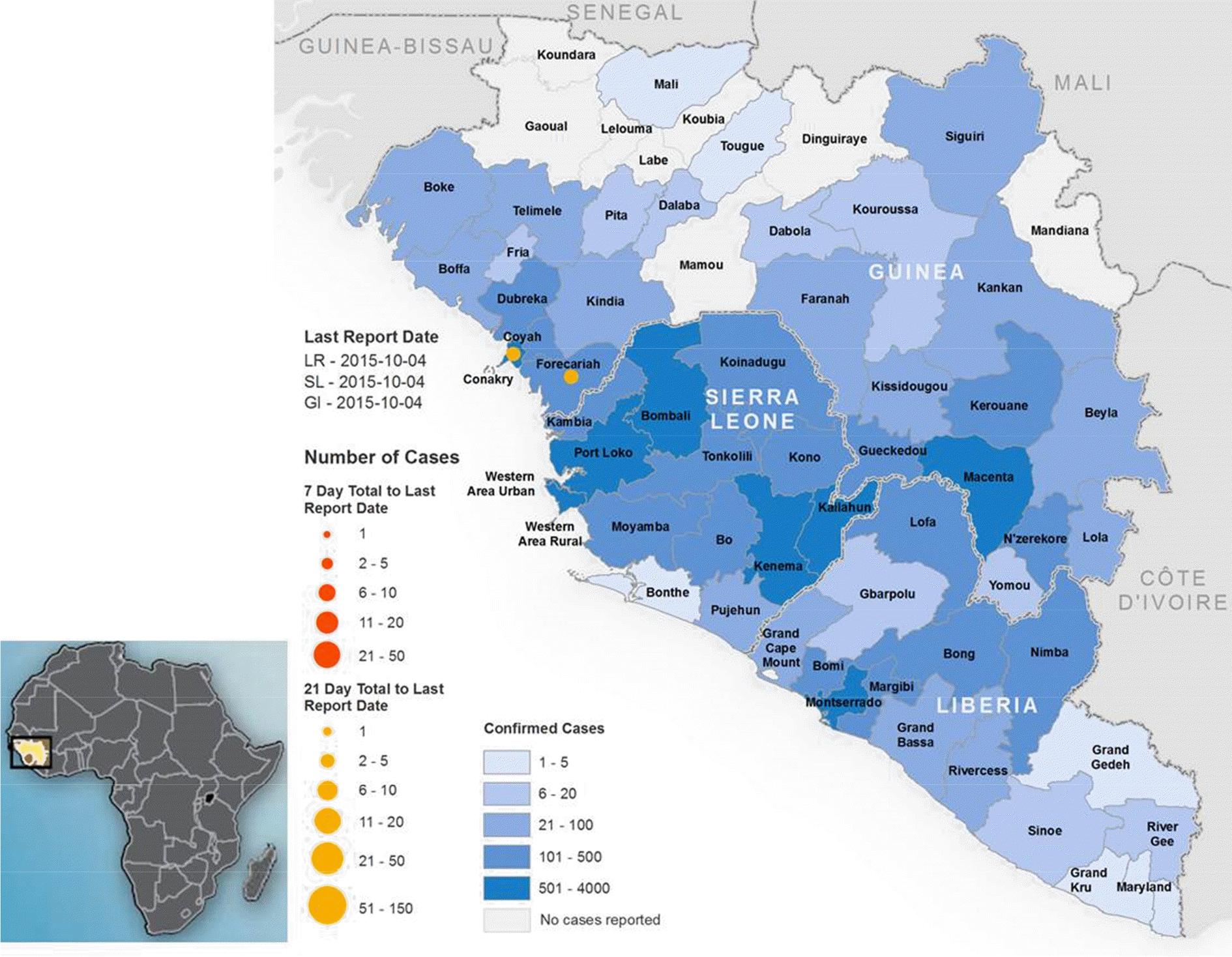Abstract
Zaire Ebola virus (EBOV) is a fatal human pathogen, with a high case fatality rate (CFR) averaging up to 78%. In March 2014, the World Health Organization (WHO) was made aware of a ZEBOV outbreak in rural Guinea, West Africa. Epidemiologic investigation linked the clinical and laboratory confirmed cases with the presumed first fatality of the outbreak in December 2013. EBOV from Guinea is a separate clade from other ZEBOV strains reported from the Democratic Republic of Congo (DRC) and Gabon. Since the outbreak in March, ZEBOV was also reported in Conakry, Guinea's capital and spread to other neighboring countries. In its largest outbreak, ZEBOV disease expanded through Guinea, Liberia, Sierra Leone, and Nigeria and to Spain, the USA, and the UK. The WHO declared the 2013–2015 West African Ebola epidemic a public health emergency of international concern considering its presumable capacity for further international spread. Early manifestations of EVD (Ebola virus disease) include a high fever, body aches, malaise, and fatigue. Severe diarrhea and other gastrointestinal manifestations such as vomiting were common, while bleeding was a more sporadic finding. The fatality rate was 43% and highest in patients aged ≥ 45 years and the overall fitted mean incubation period was 10.3 days (95% CI 9.9~10.7). We present a review of the literature on the emergence of Ebola, and the epidemiologic, clinical, and laboratory records of patients in whom EVD was diagnosed in Sierra Leone, Guinea, Liberia, Mali, the USA, and Spain, its zoonotic origin, and the transmission of ZEBOV, as well as presenting original literature on the current Ebola outbreak.
Go to : 
REFERENCES
1). Baize S, Pannetier D, Oestereich L, Rieger T, Koivogui L, Magassouba N, et al. Emergence of Zaire Ebola virus disease in Guinea. N Engl J Med. 2014; 9(371):1418–25.

3). Osterholm MT, Moore KA, Kelley NS, Brosseau LM, Wong G, Murphy FA, et al. Transmission of Ebola viruses: what we know and what we do not know. mBio. 2015; 6:e00137.

4). Gire SK, Goba A, Andersen KG, Sealfon RS, Park DJ, Kanneh L, et al. Genomic surveillance elucidates Ebola virus origin and transmission during the 2014 outbreak. Science. 2014; 345:1369–72.
5). Olival KJ, Hayman DT. Filoviruses in bats: current knowledge and future directions. Viruses. 2014; 6:1759–88.

6). Schieffelin JS, Shaffer JG, Goba A, Gbakie M, Gire SK, Colubri A, et al. Clinical illness and outcomes in patients with Ebola in Sierra Leone. N Engl J Med. 2014; 371:2092–100.

7). Bah EI, Lamah MC, Fletcher T, Jacob ST, Brett-Major DM, Sall AA, et al. Clinical presentation of patients with Ebola virus disease in Conakry, Guinea. N Engl J Med. 2015; 372:40–7.

8). Chertow DS, Kleine C, Edwards JK, Scaini R, Giuliani R, Sprecher A. Ebola virus disease in West Africa–clinical manifestations and management. N Engl J Med. 2014; 371:2054–7.
9). Ansumana R, Jacobsen KH, Sahr F, Idris M, Bangura H, Boie-Jalloh M, et al. Ebola in Freetown area, Sierra Leone–a case study of 581 patients. N Engl J Med. 2015; 372:587–8.
10). Varkey JB, Shantha JG, Crozier I, Kraft CS, Lyon GM, Mehta AK, et al. Persistence of Ebola Virus in Ocular Fluid during Convalescence. N Engl J Med. 2015; 372:2423–7.

11). Christie A, Davies-Wayne GJ, Cordier-Lasalle T, Blackley DJ, Laney AS, Williams DE, et al. Possible sexual transmission of Ebola virus – Liberia, 2015. MMWR Morb Mortal Wkly Rep. 2015; 64:479–81.
12). WHO Ebola Response Team. Ebola virus disease in West Africa–the first 9 months of the epidemic and forward projections. N Engl J Med. 2014; 371:1481–95.
13). Chan M. Ebola virus disease in West Africa–no early end to the outbreak. N Engl J Med. 2014; 371:1183–5.
14). The National Academies Collection: Reports funded by National Institutes of Health. Research Priorities to Inform Public Health and Medical Practice for Ebola VirusDisease: Workshop in Brief. Washington D. C.: National Academies Press (US);2014.
15). Jaax N, Jahrling P, Geisbert T, Geisbert J, Steele K, McKee K, et al. Transmission of Ebola virus (Zaire strain) to uninfected control monkeys in a biocontainment laboratory. Lancet. 1995; 346:1669–71.

16). CDC. Review of human-to-human transmission of Ebola virus. 2014. http://www.cdc.gov/vhf/ebola/transmission/human-transmission.html.
17). Jones RM, Brosseau LM. Ebola virus transmission via contact and aerosol-a new paradigm. Minneapolis, M.N.: Center for Infectious Disease Research and Policy, University of Minnesota;2014.
18). Roy CJ, Milton DK. Airborne transmission of communicable infection–the elusive pathway. N Engl J Med. 2004; 350:1710–2.
19). Sinn PL, Hickey MA, Staber PD, Dylla DE, Jeffers SA, Davidson BL, et al. Lentivirus vectors pseudotyped with filoviral envelope glycoproteins transduce airway epithelia from the apical surface independently of folate receptor alpha. J Virol. 2003; 77:5902–10.

Go to : 
 | Figure 1.
Geographical distribution of new and total confirmed cases in Three Countries in Africa. The map shows the districts that have been affected by EVD in Guinea, Liberia, and Sierra Leone. Yellow circles indicated the total number reported during 21 days and red circles indicated the total number reported during 7 days leading up to October 25, 2015. ○ C 2015 World Health Organization |




 PDF
PDF ePub
ePub Citation
Citation Print
Print


 XML Download
XML Download